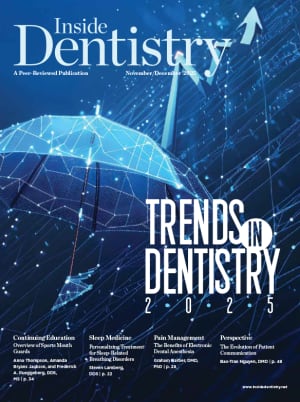Digitally Planned, Fully Guided Implant Placement
CBCT facilitates comprehensive diagnosis and treatment
Dental implants have transformed the field of restorative dentistry, providing patients with a reliable and esthetically pleasing solution for tooth loss. In implant dentistry, cone-beam computed tomography (CBCT) plays a critical role by providing detailed three-dimensional images of the oral and maxillofacial structures, and digital software applications complement its use by streamlining implant planning and restoration design.1
Although panoramic radiographs can provide insights into edentulous areas, they are unreliable in providing accurate measurements. Their inherent two-dimensional limitation restricts the ability to properly assess the buccal, palatal, and lingual dimensions. Consequently, panoramic radiographs exhibit constraints when assessing the remaining height and width of edentulous future implant sites and do not represent the gold standard in imaging techniques for implant surgery.
A high-resolution 3D perspective from a CBCT system, however, proves invaluable in such cases. CBCT enables meticulous examination of edentulous sites because it captures their true dimensions in three planes. By providing precise information about the location of critical anatomical landmarks, CBCT facilitates accurate assessment of edentulous sites for implant treatment. Whether for surgical phases (eg, guided, semi-guided, analog) or prosthetic planning, to ensure the most optimal outcomes for patients, CBCT is the gold standard.
Case Report
A 52-year-old female patient presented with an edentulous space at the site of tooth No. 30. To assess her suitability for dental implant placement, a comprehensive clinical examination was performed, which included a review of her medical and dental histories. After discussing the possibility of implant restoration with the patient, a CBCT system (OP 3D™ LX, DEXIS) was used to obtain a large field of view (FOV) scan (12 x 15 cm) of the maxillofacial complex (Figure 1). Notably, the edentulous area demonstrated evidence of a well-remodeled previously performed bone graft procedure. Furthermore, both the buccal and lingual cortices remained intact, and the underlying trabecular bone was determined to be within normal limits. The position of the right inferior alveolar canal was also meticulously assessed. After the site was deemed suitable to receive an implant, the patient agreed to the treatment plan.
Treatment Planning
Treatment was initiated by capturing digital intraoral scans of the upper and lower dentition (DEXIS IS 3800W, DEXIS) to accompany the CBCT scan. A bite registration was also obtained. Using digital imaging and treatment planning software (DTX Studio™ Clinic, DEXIS), the DICOM data was automatically merged with the stereolithography (STL) file, and an appropriately sized implant (Simply Iconic™ [4.7 mm × 10 mm], Implant Direct) was virtually placed to achieve the most optimal position and angulation (Figure 2). The data was then used to design the surgical guide, which was fabricated with an in-office 3D printer (Pro S, SprintRay) (Figure 3).
Airway Assessment
The single CBCT scan facilitated a seamless comprehensive assessment of the patient’s dentition, temporomandibular joint area, and airway. While visualizing the future implant site, incidental findings revealed a narrowing of the oropharyngeal airway (Figure 4), prompting a referral to a sleep specialist for suspected sleep apnea. The subsequent sleep study, which confirmed moderate to severe sleep apnea, lead to the prescription of a continuous positive airway pressure (CPAP) device.
Surgical Phase
At the surgical appointment, antibiotics (2,000 mg oral amoxicillin) were administered one hour prior to the procedure. In addition, the surgical guide was inserted intraorally to ensure passive adaptation and accuracy. Verification through open windows within the guide confirmed its precise fit. Local anesthesia (lidocaine HCL 2% with 1:100000 epinephrine, totaling 3.6 cc) was administered via buccal and lingual infiltration at the edentulous tooth No. 30 site. Following the implant manufacturer’s fully guided protocol, the osteotomy was created (Figure 5), and then the implant was delivered with a 35 Ncm insertion torque (Figure 6).
The procedure was well-tolerated by the patient. Postsurgical anti-inflammatory medication (200 mg ibuprofen) was prescribed, which the patient was instructed to take every 6 hours for pain. In addition, she was instructed to maintain a soft diet and to chew on the contralateral side of the mouth for 3 to 4 days. A postoperative follow-up assessment was scheduled to occur 2 weeks after implant insertion.
Follow-up Assessment
A medium FOV CBCT scan was obtained 2 weeks after the surgery to assess the implant’s position and surrounding structures (Figure 7). The healing period was uneventful, and the patient reported minimal discomfort. Approximately 3 months after initial placement, a postoperative low-dose single jaw follow-up CBCT scan (6 x 9 cm FOV) was acquired, which confirmed that the implant was positioned according to the treatment plan and well osseointegrated (Figure 8).
Conclusion
Until more recently, the digital treatment planning and placement of implants was a more laborious process that required multiple disparate software programs. The software used in this case seamlessly integrated the data from all of the imaging modalities into one integrated ecosystem to facilitate everything from diagnostics to implant planning. Furthermore, the use of large FOV CBCT provided comprehensive diagnostic details that were crucial for precise treatment planning, surgical decision-making, and ultimately, the patient’s overall health.
About the Author
Katya Archambault, DMD
San Diego Dental Health Center
La Jolla, California
Clinical Instructor
Department of Surgery
Division of Otolaryngology
University of California
San Diego
San Diego, California
